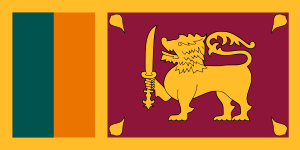Indian South Africans
Indian South Africans are citizens and residents of South Africa of South Asian descent. The majority live in and around the city of Durban, making it "the largest 'Indian' city outside India".[2] Many Indians in South Africa are descendants of migrants from colonial India (South Asia) during late 19th-century through early 20th-century. At times Indians were subsumed in the broader geographical category "Asians".[3]
| Total population | |
|---|---|
| 1,274,867[1] 2.5% of the South African population (2011)[1] | |
| Regions with significant populations | |
| Durban • Cape Town • Johannesburg • Pretoria • Pietermaritzburg | |
| Languages | |
| South African English • Hindi • Urdu • Gujarati • Punjabi • Marathi • Awadhi/Bhojpuri dialects • Tamil • Telugu • Malayalam • Kannada • Other languages of South Asia • Other languages of South Africa | |
| Religion | |
| Hinduism • Islam • Christianity | |
| Related ethnic groups | |
| Indian diaspora |
There remains a cultural, religious and racial overlap for "Asians" and "Indian South Africans". During the most intense period of segregation and apartheid, "Indian", "Asian", "Coloured" and "Malay" group identities controlled numerous aspects of daily life, including where a classified person was permitted to live.[4]
During ideological apartheid from 1948 to 1994, Indians were called and often voluntarily accepted, terms that ranged from "Asians" to "Indians". Some citizens believed that these terms were improvements on the negatively defined identity of "Non-White", which was their previous status. Politically conscious and nationalistic Indian South Africans wanted to show both their heritage and their local roots. Increasingly they self-identified as "African", "South African" and, when necessary, "Indian South Africans".
Nonetheless, the spread of democratic elections has sometimes heightened ethnic loyalties. Politicians and groups have looked for means to mobilise power in the competitive parliamentary democracy which South Africa has become since 1994.[5]
History
Traders from India may have been active on the eastern coast of South Africa for centuries, including before the Dutch settlement of the Cape Colony in 1652.[6]
Dutch servitude in the Cape
A significant proportion of slaves imported into the Cape were from parts of India.[7] While South African scholars mistakenly assumed these slaves were bought in "slave markets", many of the slaves were victims of kidnapping.[7] Many slaves had no identity as Indians and were subsumed into the "Cape Coloured" and Cape Malay communities.[8] White Afrikaners also may have some Indian slave ancestry,[7] an example of this being former State President F.W. de Klerk, who revealed in his autobiography that one of his ancestors was a female slave called Diana of Bengal.[9] There is no reference to the real names of these Indians and were given "Christian" names for convenience. This all contributed to the loss of identity similar to the Mozambicans and other slaves who were brought to the Cape.
An early Indian to settle in South Africa was Kalaga Prabhu, a Goud Saraswat Brahmin merchant from Cochin. He was the foremost among the Konkani merchants in Cochin (modern day Kochi in Kerala). As punishment for conspiring with the Mysorean Muslim king Hyder Ali to overthrow the king of Cochin, Kalaga Prabhu and his son Chorda Prabhu were arrested by the Dutch and exiled with their families for life to the Cape of Good Hope in 1771. No further record of this individual and his descendants if any exists.[10]
Indentured labourers and passenger Indians
The modern South African Indian community is largely descended from Indians who arrived in South Africa from 1860 onwards. The first 342 of these came on board the Truro from Madras,[11][12] followed by the Belvedere from Calcutta.[12] They were transported as indentured labourers to work on the sugarcane plantations of Natal Colony, and, in total, approximately 200,000 Indians arrived as indentured labourers over a period of 5 decades,[12][13] later also as indentured coal miners and railway workers.[14][15] The indentured labourers tended to speak Tamil, Telugu, and the Bhojpuri and Awadhi dialects of Hindi,[16] and the majority were Hindu with Christians and a few Muslims among them.[12] Indians were imported as it was found by colonial authorities that local black Africans were economically self-sufficient, and thus unwilling to subject themselves to employment by colonial farmers, while other colonial authorities believed that the "hunting and warrior" African culture of the time was incompatible with a sudden shift to employed labour. The Mercury newspaper favoured the importation of labour, although other Natal newspapers were against the idea. In general, the importation of labour was not viewed as politically important by colonists when it was proposed, and the importation of Indian labour was driven by lobbying by a relatively small group of sugar planters, and the long-term consequences of Indian immigration (the establishment of a permanent Indian population in Natal) were not taken into account.[17] (by 1904, Indians outnumbered whites in Natal).[18] Although 1860 is dated as the beginning of Indian settlement in Natal, a farmer called ER Rathbone was the first to introduce Indian labour to the colony in 1849.[11][19]
Indentured labourers on sugar plantations were frequently mistreated, and lived in unsanitary conditions. A large percentage of indentured labourers returned to India following the expiry of their terms, and some of those who returned alerted authorities in India to abuses taking place in Natal, which led to new safeguards being put in place before further recruiting of indentured labourers was allowed to take place.[14]
Former indentured labourers who didn't return to India quickly established themselves as an important general labour force in Natal particularly as industrial and railway workers, with others engaging in market gardening, growing most of the vegetables consumed by the white population.[20] Indians also became fishermen, and worked as clerks; in the postal service; and as court interpreters.[15]
The remaining Indian immigration was from passenger Indians, comprising traders and others who migrated to South Africa shortly after the indentured labourers,[11] paid for their own fares and travelled as British Subjects. These immigrant Indians who became traders were from varying religious backgrounds, namely Hindu and Muslims but largely from Gujarat (including Memons and Surtis),[21] later joined by Kokanis, and Urdu speakers from Uttar Pradesh.[20] The Muslims played an important part in the establishment of Islam in the areas where they settled. Indian traders were sometimes referred to as "Arab traders" because of their dress, and because large numbers of them were Muslim.[21]
Passenger Indians, who initially operated in Durban, expanded inland, to the South African Republic (Transvaal), establishing communities in settlements on the main road between Johannesburg and Durban. Natal's Indian traders rapidly displaced small white shop owners in trade with other Indians, and with black Africans, causing resentment among white businesses.
Researchers have made efforts to collect and make available shipping lists of Indian immigrants.[22]
Early discrimination
Indians faced discrimination to varying degrees in all the parts of South Africa.
Natal
Indians faced repressive legislation in Natal. They were forced to carry passes in 1888.[11] In 1893, M. K. Gandhi arrived in South Africa to represent an Indian businessman in a legal dispute. Following his arrival in South Africa, Gandhi experienced racial discrimination, and, following the proposal of legislation to restrict Indian voting rights in Natal, he helped organise resistance, leading to the formation of the Natal Indian Congress.[11][13] This organised resistance led to the unification of disparate groups of South African Indians for the first time.[23] Although the bill was defeated, it was successfully reintroduced in 1896.[11]
Transvaal
The South African Republic government first instituted discriminatory legislation against Indians in 1885,[11] which led to protests from the British authorities, as the Indians were British Subjects, and was used as one of the justifications for the Anglo-Boer War.[20] Indians were banned from working in the mining industry, and areas were set aside for coolie locations in various towns in the Transvaal. Persons of colour could also not walk on sidewalks in the Transvaal.[11] Following the end of the second Anglo-Boer War, the new British government of the Transvaal Colony continued discriminatory practices against Indians.[24]
Cape Colony
Passenger Indians who moved to the Cape Colony, although facing petty discrimination, were generally well treated, could own property, could vote, and could trade freely. Many Muslim men in this group married Cape Malay women, and their children were later often classified as Cape Malay.[20]
Orange Free State
Indians were prohibited by an 1891[11] statute from living in the Orange Free State, then an independent Boer Republic, and this led to the almost total absence of Indians from the area, a situation that persisted into the apartheid era. [25]
Apartheid
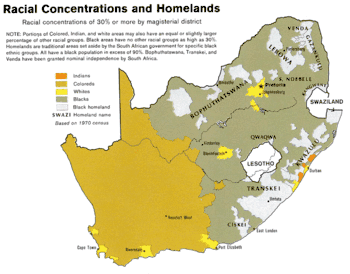
The Durban riots was an anti-Indian riot predominantly by Zulus targeting Indians in Durban, South Africa in January 1949. The riots resulted in the massacre of mostly poor Indians. In total 142 people died in the riots and another 1,087 people were injured. It also led to the destruction of 58 shops, 247 dwellings and one factory.[26]
Discriminated against by apartheid legislation, such as the Group Areas Act, applied in 1950, Indians were forcibly moved into Indian townships, and had their movements restricted. They were not allowed to reside in the Orange Free State Province, and needed special permission to enter that province. They were also, as a matter of state policy, given an inferior education compared to white South Africans. The Asiatic Land Tenure and the Indian Representative Act of 1946 were repealed.
The Population Registration Act, 1952 initially defined Indians as being part of the Coloured population.[27]
In 1961, Indians were officially recognised as permanent part of the South African population,[28] the Department of Indian Affairs was established, with a white minister in charge. In 1968, the South African Indian Council came into being, serving as a link between the government and the Indian people.
The University of Durban-Westville (now part of the University of KwaZulu-Natal) was built with a Rand-for-Rand contribution from Indian South Africans and the government in the 1970s. Before that, Indian students had to take a ferry to Salisbury Island's abandoned prison, which served as their university.[29]
Casual racist expressions were used during the years of apartheid. Indians in South Africa were (and sometimes still are) referred to by the racial epithet 'coolie'.[30]
In 1968, the South African Indian Council (not to be confused with the anti-apartheid South African Indian Congress which had the same initials) was created by the government, and in 1974, the council was reconstituted to allow for 50% of its members to be elected by Indians. The Council did not enjoy much support, for example, in 1981, only 6% of eligible voters participated in elections for the council.[31]
In 1983, the Constitution was reformed to allow the Coloured and Indian minorities a limited participation in separate and subordinate Houses of a Tricameral Parliament, a development which enjoyed limited support and very low voter turnouts.[32] The Indian house was called the House of Delegates. Some aspects of Indian life were regulated by this house, including education. The theory was that the Indian minority could be allowed limited rights, but the Black majority were to become citizens of independent homelands. These separate arrangements were removed by the negotiations which took place from 1990 on to provide all South Africans with the vote.
Post-apartheid
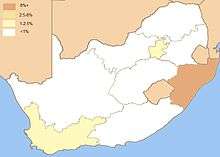
Post-apartheid politics
Many Indians played an important role in the anti-apartheid struggle and some occupied positions of power in post-apartheid South Africa. In post-apartheid South Africa, Indians have maintained prominent positions in the ruling African National Congress.
Amichand Rajbansi's Minority Front (formerly the National People's Party) retained some support in its strongholds. However, after Rajbansi's death in 2011, the party failed to win any seats in the national assembly following the 2014 general election.[33]
Indians who were citizens before 1994, and thus discriminated against by the apartheid system, are considered black for the purposes of Employment Equity; that is, they are classified as having been disadvantaged under apartheid. They are thus eligible for "affirmative action" and Black Economic Empowerment allocations.[34]
Renewed immigration
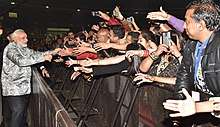
Following the end of apartheid, a new wave of South Asian immigration commenced from India, Bangladesh and Pakistan, paralleling the movement of Africans from the diaspora and neighbouring African countries to the post-apartheid South Africa. Among these post-apartheid immigrants, the controversial Gupta family from India, managed to acquire vast political and economic influence in a short time, under the reign of former President Jacob Zuma.[35][36][37][38][39]
Religion
Almost all South African Indians are either Hindu, Muslim, or Christian.[41] There are also small groups of Parsis, Sikhs, and Buddhists.[42] The majority of South African Muslims are Indian or belong to the multi-ethnic community in the Western Cape.[43]
The proportion of Indian South Africans following Hinduism has decreased from 50% in 1996 to 47.27% in 2001.[44] This further decreased to 41.3% in 2016 , mainly due to the conversion of "Hindus into Christian" by the Christian missionaries.[45]
Education
Until 1991, state government schools taught in English, with the choice of one of five Indian languages, namely Hindi, Gujarati, Tamil, Telugu and Urdu to be taken as non-examination subjects. But, the languages were dropped from state run schools. The national council for eastern languages have requested the government to teach these five languages. The provincial government agreed to allow these languages to be taught in KwaZulu-Natal. These languages can be chosen as third language up to final year of school.[46]
Languages
English is the first language of most Indian South Africans. A minority, especially older people, still speak some Indian languages such as Hindi, Gujarati, Marathi, Bengali, Odia, Tamil, Telugu, Urdu and others as a first language or second language. Most younger people do not speak any other languages, besides English and the compulsory second language taught at school, such as Afrikaans or Zulu.
Many South African Indians still understand a variety of Indian languages to varying degree, often as a result of promotion by cultural organisations,[16] or the influence of Bollywood. Recent immigrants have maintained fluency in their mother tongues.
Cuisine
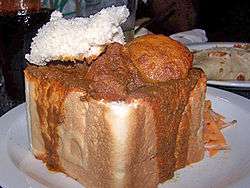
Curried dishes are popular in South Africa among people of all ethnic origins; many dishes came to the country with the thousands of Indian labourers brought to South Africa in the nineteenth century. The Indians have introduced a different line of culinary practices, including a variety of curries, roti's, sweetmeats, chutneys, fried snacks such as samosa (called samoosa in South Africa), and other savoury foods. Bunny chow, a dish from Durban (which has a large Indian community) consisting of a hollowed-out loaf of bread filled with curry, has adapted into mainstream South African cuisine and has become quite popular.
Media and entertainment
Although Indian languages are seldom spoken or understood by younger Indians, English-subtitled Indian films and television programmes remain popular among South African Indians. These are broadcast both by the DStv satellite television service, which carries Zee TV, B4U, NDTV, and a Hindi-language Sony channel. In addition, Tamil–language channels, Sun TV and KTV, were introduced in 2004.
The largest website dedicated to Indian South Africans is Indian Spice. It publishes news in all aspects of public life that affect the South Asian community in Southern Africa (including Mauritius and Kenya) and conducts journalistic investigations of its own into matters of criminal, political and social interest through its subsidiary Kali.
DVD, and previously, video versions of Bollywood films are widely available. Large cinema chains like Ster-Kinekor began showing Bollywood films by the early 2000s . Indian culture in South Africa has some similarities to the worldwide Desi subculture, however, South African Indians developed a distinctive musical and literary culture of their own, which has to some extent been eclipsed by the global Bollywood/Desi culture in the 1990s and 2000s.[48]
The slang term charou (various spellings) is often used by Indians, particularly in the Durban area, to refer to themselves.[49][50]
Card games, in particular, the trick-taking card game Thunee (similar to Twenty-eight) are popular among South African Indians.[51]
Radio Hindvani is a community radio station based in Durban and is aimed at the promotion of Hindi culture and language amongst South Africans. The station's frequency reaches Durban and all surrounding areas.
The South African Broadcasting Corporation (SABC) also has an Indian-oriented radio service called Lotus FM, launched during the apartheid era. SABC 3 is also known to show a Bollywood movie on Sunday afternoons. The Sunday Times has a supplement distributed in Indian areas called the Extra, and the Sunday Tribune publishes a similar supplement, called the Herald. A Bollywood section, 'Bollyworld' is published by the Daily News on Mondays.
Events
Among the major charity and cultural events in South Africa, organised every year by the local Indian community are:
Gandhi Walk
Held annually in Lenasia, south of Johannesburg, the Gandhi Walk is the oldest event in South Africa commemorating Mahatma Gandhi. It has been held 34 times in with the last edition being 2019. The 35th edition in 2020 was postponed due to the Coronavirus outbreak.[52][53][54]
Durban Festival of Chariots
Durban Festival of Chariots is organised annually at the beachfront by the ISKCON. The festival is attended by tens of thousands of people.[55]
Notable Indian South Africans
|
|
See also
- Asians in Africa
- Memons in South Africa
- Tamil diaspora
- Tamil South Africans
- Romani people
References
- "Statistical Release P0302: Mid-year population estimates, 2011" (PDF). Statistics South Africa. 27 July 2011. p. 3. Retrieved 1 August 2011.
- Mukherji, Anahita (23 June 2011). "Durban largest 'Indian' city outside India". The Times of India. Retrieved 30 November 2011.
- Noble, Kenneth B. (22 April 1994). "Fearing Domination by Blacks, Indians of South Africa Switch Loyalties". The New York Times. Retrieved 5 May 2010.
- "BBC World Service | Bridgin the divide: Indians in South Africa". Bbc.co.uk. Retrieved 6 November 2011.
- SookDeo, A. "The Transformation of Ethnic Identities; the case of 'Coloured' and Indian South Africans", Journal of Ethnic Studies, Winter 1987–1988. (Western Washington University, Bellingham, Washington)
- "Indians - South Africa Culture". www.krugerpark.co.za. Retrieved 2 August 2020.
- "INDIAN SLAVES IN SOUTH AFRICA". Archived from the original on 20 March 2008. Retrieved 24 November 2011.
- "From bondage to freedom – The 150th anniversary of the arrival of Indian workers in South Africa". Archived from the original on 1 August 2010. Retrieved 24 November 2011.
- Morris, Michael (8 February 1999). "South Africa: FW de Klerk Reveals Colourful Ancestry". Allafrica.com. Retrieved 29 August 2017 – via AllAfrica.
- "History of Saraswat Migrations". gsbkerala.com. Archived from the original on 13 April 2010. Retrieved 11 May 2018.
- "Timeline". Archived from the original on 6 June 2011. Retrieved 24 November 2011.
- "A History of Indian Settlement in KwaZulu-Natal". Kzn.org.za. Retrieved 6 November 2011.
- "History of KwaZulu-Natal Indian Settlement ...cont. Part 2". Kzn.org.za. Retrieved 6 November 2011.
- "Indentured Indians who returned to India from Natal". Ancestry24. Archived from the original on 7 July 2011. Retrieved 6 November 2011.
- "The Victoria Street Indian Market 1910-1973" (PDF). University of Durban-Westville. November 1988. Retrieved 12 June 2013.
- "Archived copy". Archived from the original on 28 July 2011. Retrieved 4 February 2011.CS1 maint: archived copy as title (link)
- "Towards a new labour dispensation : Background to the arrival of Indians in Natal in 1860" (PDF). Natalia.org.za. Retrieved 29 August 2017.
- "Gandhi's Natal : The State of the Colony in 1893" (PDF). Natalia.org.za. Retrieved 29 August 2017.
- "Indentured Labour and India". Archived from the original on 5 May 2006. Retrieved 24 November 2011.
- "The Beginnings of Protest, 1860–1923 | South African History Online". Sahistory.org.za. 6 October 2011. Retrieved 6 November 2011.
- "Indian Family Businesses in Natal, 1870 – 1950" (PDF). Natalia.org.za. Retrieved 29 August 2017.
- "Arrival of Indian Passengers". Ancestry24. Archived from the original on 3 July 2010. Retrieved 6 November 2011.
- "The Beginnings of Protest, 1860–1923 | South African History Online". Sahistory.org.za. Retrieved 6 November 2011.
- "Timeline". Archived from the original on 7 June 2011. Retrieved 24 November 2011.
- "Anti-Indian Legislation 1800s – 1959 | South African History Online". Sahistory.org.za. Retrieved 6 November 2011.
- "The Durban riots, 1949". South African History Online. Retrieved 23 October 2012.
- "1950. Population Registration Act No 30". O'Malley. Archived from the original on 30 March 2018. Retrieved 11 May 2018.
- "Towards a common cause, 1961–1982 | South African History Online". Sahistory.org.za. 6 October 2011. Retrieved 6 November 2011.
- Govinden, Devarakshanam (Betty) (January 2011). "Remembering "Salisbury Island"". Yesterday and Today (6): 53–62. ISSN 2223-0386.
- "Malema under fire over slur on Indians". News24.com. Retrieved 29 August 2017.
- "South African Indian Council". Nelsonmandela.org. Retrieved 29 August 2017.
- "2014 National and Provincial Elections Results". Elections.org.za. Archived from the original on 10 May 2014. Retrieved 29 August 2017.
- "BROAD-BASED BLACK ECONOMIC EMPOWERMENT ACT : Section 9(5): Codes of Good Practice" (PDF). Thedti.gov.za. Retrieved 29 August 2017.
- "Are the Guptas the new Shaiks?". The M&G Online. Retrieved 29 August 2017.
- "Redirecting..." Secure.financialmail.co.za. Archived from the original on 30 April 2012. Retrieved 29 August 2017.
- "Cosatu raises red flag on Guptas". Mg.co.za. 25 February 2011. Retrieved 6 November 2011.
- "Zuma faces ANC revolt over Guptas". Times LIVE. 27 February 2011. Retrieved 6 November 2011.
- "Solving the 'sordid Gupta saga'". Independent Online. 7 May 2013. Retrieved 7 May 2013.
- Behind God Swapping in Indian South African Community, The Conversation
- "South Africa – Religion". Countrystudies.us. Retrieved 6 November 2011.
- "[Buddhasa] Buddhism in South Africa – Home". Buddhasa.org.za. Archived from the original on 22 November 2009. Retrieved 6 November 2011.
- "International Religious Freedom Report 2005". US State Department. Retrieved 4 June 2013.
- United States Department of State
- Holmes, Catesby (27 June 2016). "Behind the God-swapping in the South African Indian community (part 2)." The Conversation. Retrieved 10 December 2019.
- "Indian languages to be official subjects in South African schools". NDTV.com. 20 March 2014.
- Jaffrey, Madhur (2003). From Curries to Kebabs: Recipes from the Indian Spice Trail. p. 184. Retrieved 28 September 2015.
- "Charou 4 Eva :: Chatsworth Till I Die". Charous.webs.com. Archived from the original on 17 June 2010. Retrieved 29 August 2017.
- "Charou 4 Eva :: Chatsworth Till I Die". Freewebs.com. Retrieved 29 August 2017.
- "Rules of Card Games: Twenty-Eight". Pagat.com. Retrieved 29 August 2017.
- http://www.gandhiwalk.org.za/
- https://comarochronicle.co.za/205489/annual-gandhi-walk-postponed/
- https://www.deccanherald.com/international/world-news-politics/coronavirus-indian-community-events-in-south-africa-stand-cancelled-814157.html
- https://highwaymail.co.za/371233/durban-festival-chariots-postponed-due-coronavirus/
